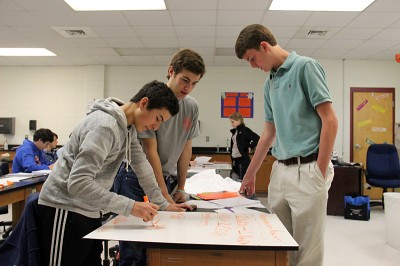The decline of science education in Mississippi: A view from the classroom
GULFPORT, Miss. — Two 10th-graders stand over a large whiteboard in their chemistry class at Gulfport High School, trying to recall the previous day’s experiment so they can present it to the class.
“What substances did we use?” the first student asks.
His classmate picks up a paper with notes and examines it for a moment. “It was sodium hydroxide and…”

Nick Medina, Bennett Webb, and Dylan Robicheaux, students at Gulfport High School, write down observations from the previous day’s science lab. (Photo by Jackie Mader)
The first interrupts excitedly before his classmate can finish and quickly writes on the whiteboard. “It was sodium bicarbonate decomposed to create disodium oxide in water. And carbon dioxide.”
At Gulfport High, such hands-on learning through experiments is common. Laboratories are well stocked with equipment and supplies. The school boasts a large classroom dedicated to building and testing robots, and its robotic team has won several awards. There’s even a separate wing where students can practice in-demand skills like repairing cars and welding.
Gulfport High, though, is an anomaly in Mississippi, a state that lags behind in both the types of science classes offered and the way students are taught. Students post some of the lowest test scores in the country on national tests. Only 19 percent of Mississippi’s eighth-graders scored proficient or
Left behind in science: Why Mississippi’s children lose out on STEM jobs
COLUMBUS, Miss. — At the end of his sophomore year, Damonta Morgan left Clarksdale High School as one of its top students. He transferred to The Mississippi School for Mathematics and Science, hoping for more challenging courses to prepare himself for college and a career as a biology professor. He soon learned how ill-prepared he was. “I wasn’t behind for Clarksdale High School,” Morgan said on a
